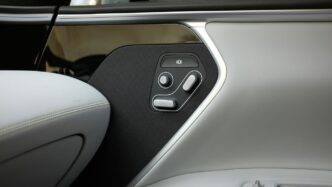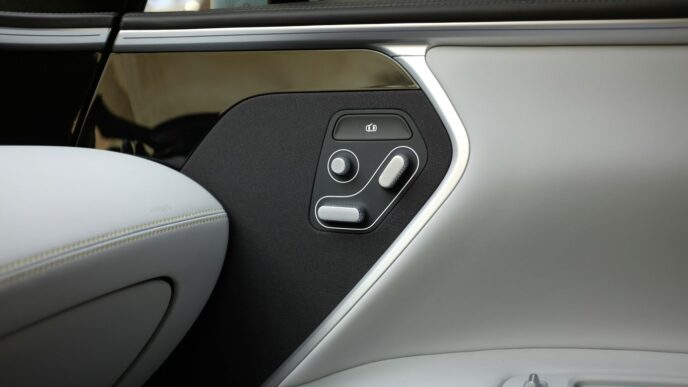Mobileye’s Pioneering Role In Autonomous Driving
Mobileye has been at the forefront of making cars smarter and safer for a long time. It all started back in 1999 with Professor Amnon Shashua’s idea to use cameras and software to spot other vehicles. This wasn’t just a lab experiment; it was about making this technology real and affordable for everyday cars. They’ve spent years building up their knowledge, especially in machine learning, which is the brainpower behind these smart systems.
Decades Of Machine Learning Expertise
Think of Mobileye as having a really long history with artificial intelligence, specifically for cars. They’ve been working on machine learning for decades, long before it became a buzzword. This deep experience means they’ve learned a lot about what works and what doesn’t when it comes to teaching cars to ‘see’ and react.
Driving AI For Autonomy At Scale
Mobileye isn’t just building AI for a few fancy concept cars. Their goal is to bring self-driving capabilities to the masses. They focus on creating AI systems that are practical, efficient, and safe enough to be put into millions of vehicles. This means their technology needs to work reliably everywhere, from busy city streets to open highways.
Modular Product Portfolio For Scalability
One of the smart things Mobileye has done is create a range of products that can grow with the technology. They have a modular system, meaning you can start with basic driver assistance features and then add more advanced capabilities as the technology develops. This approach allows carmakers to adopt Mobileye’s solutions step-by-step, making it easier to scale up to fully autonomous vehicles.
The Mobileye Compound AI System
So, what exactly makes Mobileye’s approach to self-driving tech tick? It’s all about their "Compound AI System." Think of it as a really smart brain for cars, built from the ground up specifically for driving. They’ve managed to combine advanced artificial intelligence with precise engineering. This isn’t just about throwing a bunch of AI algorithms at the problem; it’s about making sure those algorithms work perfectly with the hardware and are designed with safety as the top priority.
Blending AI With Engineered Precision
Mobileye’s system is designed to be both intelligent and reliable. They’ve put a lot of work into making sure the AI can make safe, predictable decisions, even in tricky situations. It’s a blend of machine learning, computer vision, and a solid mathematical model for safety. This means the system doesn’t just react; it understands and anticipates. The goal is to create automated driving that’s not only functional but also explainable and trustworthy.
Purpose-Built SoC Family
At the heart of this system are Mobileye’s own System-on-Chip (SoC) processors, like the EyeQ family. These aren’t just off-the-shelf chips; they’re designed specifically for the demands of automotive applications. This allows for a really efficient setup where the hardware and software work together perfectly. It’s a scalable approach, meaning they can use these chips for everything from basic driver assistance features to full self-driving capabilities. This modularity is key to getting the technology out to a lot of cars without breaking the bank.
Built From The Ground Up For Automotive
What’s really interesting is that Mobileye develops both the hardware and the software in-house. This gives them a lot of control over how everything works together. They started this process way back when, and it’s led to a highly efficient system that offers a great balance of performance and cost. This integrated approach is how they can make sure the technology is not only advanced but also practical for mass production. It’s about building something that’s safe and ready for the real world, not just a lab experiment.
Mobileye Drive™: Enabling Driverless Mobility

An End-to-End Self-Driving System
Mobileye Drive™ isn’t just a piece of the puzzle; it’s the whole picture for making vehicles truly driverless. Think of it as a complete package designed to take the human out of the driver’s seat for good. This system is built to handle everything from robotaxis and ride-sharing services to public transport and even delivering goods. It pulls from Mobileye’s massive experience with driver-assist tech found in over 150 million cars already on the road, but takes it a big step further into full autonomy. It’s a robust, road-tested solution ready for the autonomous future.
Designed For Safety And Global Deployment
Safety is obviously a huge deal when you’re talking about cars that drive themselves. Mobileye has put a lot of thought into how they test and validate Mobileye Drive™. The goal is to meet global safety standards and, ideally, be safer than a human driver. This system is also built to work pretty much anywhere. Whether you’re on a highway, a country road, or deep in a city, and in all sorts of weather or traffic conditions, Mobileye Drive™ is designed to handle it. It’s not just for one type of car either; it can be fitted into different vehicle platforms, making it a flexible choice for companies looking to add autonomous capabilities.
Adaptable To Local Driving Cultures
Driving isn’t the same everywhere, right? What works in one city might be a bit odd in another. Mobileye Drive™ is smart enough to learn and adapt to these local quirks. It can adjust to different speed limits and driving habits specific to the area it’s operating in. This means a robotaxi in Tokyo will behave differently than one in Berlin, making the ride feel more natural and less jarring for passengers. This adaptability is key to making autonomous vehicles feel at home no matter where they are deployed.
A History Of Innovation With Mobileye
Founding Vision And Early Processors
It all started back in 1999 with Professor Amnon Shashua from Hebrew University. He took his research on vision systems, which could spot cars using just a camera and some software, and turned it into a company. Mobileye’s initial goal was to make car safety tech smarter by adding intelligence to simple cameras, making it affordable for everyone. They opened their first research center in 2004, and by 2008, they had the EyeQ1 processor out. This chip was a big deal because it powered driver assistance features like automatic emergency braking. You could find this tech in cars like the BMW 7 Series back then. They kept improving the chip, releasing new versions in 2010, 2014, and 2018.
Public Offering And Market Expansion
Things really took off for Mobileye in 2013 when they sold a quarter of the company for $400 million, which put their total value at about $1.5 billion. Then, in 2014, they went public on the New York Stock Exchange, raising a massive $890 million. This was the biggest IPO for an Israeli company in the US at the time. By the end of that year, their technology was already in 160 different car models from 18 automakers. They also started making moves into new areas, like robotaxi services, partnering with companies like NIO and even testing autonomous vehicles in places like New York City.
Developing A Formal Model For Safety
As self-driving cars became more of a reality, Mobileye focused on the safety aspect. In 2017, CEO Amnon Shashua and Shai Shalev-Shwartz, who was then VP of Technology, came up with a mathematical way to think about safe self-driving. They called it Responsibility-Sensitive Safety, or RSS. This system basically redefines how we think about fault and caution in driving, which could be super useful for insurance companies and even lawmakers. It’s a structured approach to making sure autonomous vehicles operate safely, even in complex situations.
Strategic Partnerships Driving Mobileye’s Growth
Mobileye didn’t build its whole autonomous driving system in a vacuum, you know. They’ve teamed up with a whole bunch of car companies and other tech folks to get their stuff into cars and onto the road. It’s like, they make the brains, and the car companies make the bodies, and together they make something that can actually drive itself.
Collaborations With Leading Automakers
This is where a lot of the action happens. Mobileye’s technology has been showing up in cars for years, starting with things like lane departure warnings. Remember those? Now, they’re working with big names like BMW, Ford, and Porsche. For instance, Ford is putting Mobileye’s camera tech and software into their cars all over the world. And Porsche is planning to use Mobileye’s SuperVision system in some of their future models. It’s a pretty big deal when these car giants decide to trust your tech for something as important as driving assistance or even full self-driving.
Expanding Into Robotaxi And Delivery Services
Beyond just putting their tech in cars you can buy, Mobileye is also getting into the robotaxi and delivery game. They’ve partnered with companies like WILLER to bring robotaxis to places like Japan and Taiwan. They’re also working with Udelv to create electric delivery vehicles that drive themselves. These partnerships are key to showing that the technology works in real-world, commercial applications, not just on test tracks. It’s a different kind of challenge, dealing with passengers or packages, and it requires a lot of trust and reliability.
Integration With Major Automotive Suppliers
It’s not just the car manufacturers themselves. Mobileye also works with big-time auto parts suppliers. Think companies like Delphi and ZF. These suppliers are already deeply connected with the car companies, making all sorts of parts. When Mobileye partners with them, it’s like getting a shortcut into the supply chain. They help integrate Mobileye’s systems into the vehicles, making sure everything fits and works correctly. It’s a smart way to spread their technology far and wide without having to deal with every single car maker directly.
The Technology Behind Mobileye’s Success

So, what makes Mobileye’s tech tick? It’s not just one thing, but a combination of smart ideas that work together. They’ve been at this for a while, building up their knowledge.
Road Experience Management™ (REM™)
Think of REM as a way for cars to build a super-detailed map of the world, but on the fly. It’s like the car is constantly learning and updating its own GPS, but way more precise. It uses the cameras in the car to see things like lane lines, signs, and road edges. This information is then sent back to create a "crowdsourced" map. This map is updated in real-time, giving the car a really good idea of where it is and what’s around it. It’s pretty neat because it means the system gets better the more cars use it.
True Redundancy™ For Enhanced Safety
When it comes to self-driving, safety is obviously a big deal. Mobileye tackles this with something they call "True Redundancy." Basically, they don’t rely on just one way of doing things. They have systems that can drive the car using cameras alone, and then separate systems that can drive using radar and LiDAR. If one system has a hiccup, the other one is there to take over. It’s like having two independent brains looking out for you. This makes the whole system much more reliable, especially in tricky situations.
Sensor Configurations For Diverse Vehicles
Not all vehicles are the same, right? A big truck needs to see things differently than a small car. Mobileye gets this. They’ve figured out how to set up their sensors – the cameras, radar, and LiDAR – in different ways depending on what kind of vehicle it is. This means they can put their technology into everything from passenger cars to delivery vans and even larger trucks, making sure each one has the right "eyes" for the job. It’s all about making the technology fit the vehicle, not the other way around.
Looking Ahead
So, Mobileye isn’t just dabbling in car tech; they’re really building the road for how we’ll all get around in the future. From helping drivers today with smarter safety features to aiming for fully self-driving cars, they’ve got a solid plan. They’ve been at this for a while, learning and growing, and it shows in the tech they’re putting out. It’s clear they’re focused on making this stuff safe and available for everyone, not just a few fancy cars. Keep an eye on Mobileye; they’re definitely a big player in shaping what driving looks like next.














